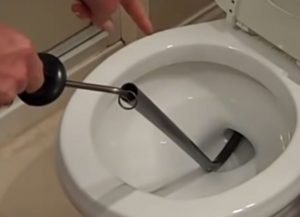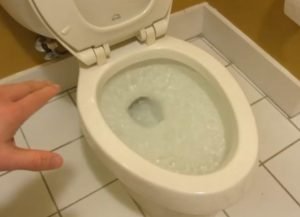A toilet clog doesn’t give us a lot of options. Some people prefer using a plunger, while others use hot water and dish soap to unclog a toilet in emergencies. But if none of these things are working, your best shot will be using a toilet snake. Also referred to as a plumbing snake, this tool works its way through the trap way up to the drain, making it very useful for unclogging toilets.
Snake a toilet could be a lifesaver when your running toilet gets clogged. So, before you consider calling a professional plumber to unclog your toilet, you should try using plumbing snakes. If you don’t have one, you can always buy one at the store and unblock your toilet.
You can check our recommended toilet snake here- DrainX plumbing snake
8 Toilet Unclogging Steps: How to Use a Toilet Snake?
Dealing with a clogged toilet without a plunger is a headache. But you can get rid of a clogged toilet by following some simple steps. A drain snake is useful with a long metal cable with a coiled hook at the front. This is great for pushing or dredging substances from your toilet’s drain. If you don’t know how to use a toilet snake, you’re in the right place. Here’s how:
Page Contents
What preventive measures should you take?
You must wear gloves and eye protection while using a toilet snake, as dirty water or objects may splash your skin or eyes and cause health issues.
Step 1: Gather tools
Before you start working on your toilet blockage, you should gather all the tools you may need to snake a toilet. These include rubber gloves, toilet plunger, bucket, bleach, and toilet snake. If you’re equipped with these tools, unclogging your toilet will be very easy.
Step 2: Familiarize yourself with the toilet snake

If you want to have ample time using the toilet snake, you should familiarize yourself with this tool. The plumbing snakes come with a rod that is housed in a thin rubber hose. On top of that, it features an angled handle that also functions as a crank on one end, and the other end goes into the toilet’s drain.
Related article: Easy steps to use a Toilet Auger
Step 3: Place the end of the snake into the toilet bowl

Lower the plumbing snake into the bowl with the metal end facing the toilet bowl. Push the snake into the mouth of the toilet’s drain. At the end of the plumbing, the snake is a hook that will help you push, dredge, or break up the clog.
Ensure the plastic or rubber end at the end of the hook is intact so that it does not damage your toilet’s surface. If it’s not intact, use tape to wrap it.
Step 4: Turn the crank handle clockwise

When the plumbing snake is in position, crank the handle clockwise to send the cable into the toilet drain. This movement will make the snake extend into the drain. Since the drain snake is made with flexible metal coils, it will bend and follow the contours of the toilet’s trap way and drain pipes without any problem.
But if it fails to turn or move forward, you can pull it back a little, quarter-turn the handle counterclockwise (opposite direction), and try again. You will repeat this procedure every time the snake becomes problematic to move or when you want to turn it. If you have any problem with the handle, you fix the handle by following some easy steps.
Step 5: Push carefully when you feel resistance

Enter the end of the cable into the toilet. As you push, you may start to feel resistance, or the snake will slow down. This is a sign that you’re reaching the blockage, and it’s causing you to stop. Push the shaft with some force to help the snake loosen up the blockage. Continue twisting the handle in a clockwise manner until the snake clears the drain.
Don’t use force but keep winding and unwinding the plumbing snake so that it can wear down the clog.
Step 6: Break up or pull out the clog

As you continue working to fix the clog, try pulling it up or breaking it into pieces. Rotate the snake in a counterclockwise direction to retract it and see what’s blocking your drain. If it’s possible, you should retract the clog instead of pushing it down the drain. If the clog is solid, it may make matters worse.
Step 7: Flush the toilet to test

If you’re sure that the clog has been removed or pushed down the drain, you can flush the toilet and see if your work has been rewarded. If not, you should try and repeat the same process. It is important to drain the water from the toilet bowl and tank.
Step 8: Dump the waste and clean the snake.
After clearing the clog, you should clean all the items you have used. Rinse and sanitize the snake after every use. Before removing the toilet snake after unclogging the toilet, you should add toilet cleaner and flush the toilet with the snake in it. This will help clear any mess before you rinse it using your garden hose outside.
Your work is done, and the clog should be a thing of the past. But if the plumbing snake fails to work, you should contact a professional plumber.
Which toilet snake is ideal for removing a clog?
Manual or motorized: Which toilet snake is recommended?
A toilet snake usually costs $15–45, depending on its type and features. Motorized toilet augers may cost more as they deliver more power and efficiency. It suits professional plumbers and requires extra caution while removing the clog. So if you are a beginner, I would recommend a manual toilet auger to get the job done at a low price.
What is the ideal toilet snake cable length?
Some snakes or augers come with a short cable that can’t navigate the trap of the clogged toilet. It is usually used for sinks or showers. Choose a toilet snake with a cable length of 10–25 feet and a maximum thickness (diameter) of 2 inches.
Recommended head type
Toothed, bulbous, or coil-headed toilet snakes are usually used for minor clogs caused by excessive tissue paper, hair, or food. On the other hand, if hard objects clog the system, you need a cutter-head snake to break and remove the solid blockage.
How to prevent clogs in the future?
- Never put non-soluble items in the toilets. This includes bottles, hair, pads, toys, condoms, and even clothes. Only toilet paper towels and waste should go down the drain.
- Always make sure that the water level in the toilet bowl and tank is at the recommended level. If the water level is low, the toilet may not push down all the waste as needed, leading to clogging.
- Don’t use excess tissue after a long call. Many clogs are caused by using excess tissue that finds a hard time going down the drain. Besides, you can flush twice if you think you have placed a lot of tissue in the toilet.
- Keep your toilet clean regularly. Give your toilet a thorough clean every week. These will help clear anything lingering in the drain and break it up before it becomes a clog. Use substances like vinegar and baking soda during a thorough cleaning.
Toilet auger vs. snake for unclogging
| Comparison | Toilet Auger | Snake |
| Operation: | Break the clog | Pull out clog |
| Weight: | Heavy | Light |
| Multi-purpose tool: | No | Yes |
| Effectiveness: | More powerful | Less powerful |
| Known as: | Water closet, plumbing snake | Top snake, drum snake |
| Coil: | Normal | Longer |
| Torque required: | More | Less |
| Ideal for: | Toilets | Sinks, bathtubs, showers, toilets |
Conclusion
Even if a plunger, vinegar, hot water, dish soap, & baking soda have failed to unclog your toilet, all hope is not lost. With a toilet snake, you can easily unclog your toilet quickly and straightforwardly. Ensure to follow the steps that we’ve provided above, and you won’t have to call a professional plumber to unblock your toilet.
Note that a toilet auger is a particular type of toilet snake. We hope you’ve received the help you’ve been looking for and can unclog your toilet without any trouble.
Hi, this is Robert Crossan, the owner of this website, has 17 years of experience in the installation, maintenance, and repair of toilets and plumbing systems. After completing the Level 2 Basic Plumbing course in 2005, I started working in both domestic and commercial buildings as a professional plumber. So I can figure out the core difference between different toilet models and brands. It also helped me monitor their work performance and setbacks.







